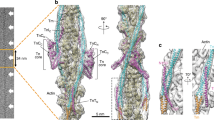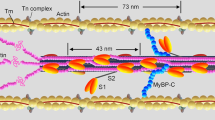Abstract
TROPONIN, a regulatory protein modifying muscular contraction is found in all the chordate striated muscles as well as in many of the invertebrate muscles which have been studied1,3. The complex of troponin and tropomyosin is bound to the actin containing thin filaments, and both components are required for thin filament-linked regulation1–3,10. In the absence of calcium the troponin–tropomyosin complex blocks the myosin combining sites, inhibiting ATPase activity and therefore contraction. When present in micromolar amounts, calcium binds to troponin and releases the inhibition. Vertebrate troponin consists of three subunits: TN-I, TN-C, and TN-T (ref. 4). TN-1 by itself (molecular weight 24,000) inhibits the actin–myosin interaction irrespective of calcium ion concentration. TN-C (molecular weight 18,000) binds calcium ions and this releases the TN-I imposed inhibition. TN-T (molecular weight 37,000) attaches the subunit complex to tropomyosin. The troponin found on arthropod thin filaments is also composed of subunits3,5,6. Components with chain weights of 29,000 and 18,000 have features analogous to those of vertebrate TN-I and TN-C respectively6. A third component is also found in arthropod troponin preparations (chain weight 55,000–59,000), but its function is not yet fully understood5,6. For convenience, this chain will be referred to here as TN-T. In spite of the overall similarity of vertebrate and arthropod troponin, invertebrate troponin differs from vertebrate troponin in calcium binding properties, and binds one-half to one-quarter of the calcium in conditions where the thin filament is maximally switchedon3,6. Moreover, the thin filament-based regulation in invertebrates is usually coupled with a myosin-linked regulatory system which is apparently not present in chordate striated muscle3,10.
This is a preview of subscription content, access via your institution
Access options
Subscribe to this journal
Receive 51 print issues and online access
$199.00 per year
only $3.90 per issue
Buy this article
- Purchase on Springer Link
- Instant access to full article PDF
Prices may be subject to local taxes which are calculated during checkout
Similar content being viewed by others
References
Ebashi, S., and Endo, M., Prog. Biophys. molec. Biol., 18, 123–183 (1968).
Murray, J., and Weber, A., Physiol. Rev., 53, 612–673 (1973).
Lehman, W., Kendrick-Jones, J., and Szent-Györgyi, A. G., Cold Spring Harb. Symp. quant. Biol., 37, 319–330 (1972).
Greaser, M. L., and Gergely, J., J. biol. Chem., 246, 4226–4233 (1971).
Bullard, B., Dabrowska, R., and Winkelman, L., Biochem. J., 135, 277–286 (1973).
Regenstein, J., and Szent-Györgyi, A. G., Biochemistry, 14, 917–925 (1975).
Kendrick-Jones, J., Lehman, W., and Szent-Györgyi, A. G., J. molec. Biol., 54, 313–326 (1970).
Lehman, W., Bullard, B., and Hammond, K., J. gen. Physiol., 63, 553–563 (1974).
Weber, K., and Osborn, M., J. biol. Chem., 244, 4406–4412 (1969).
Lehman, W., and Szent-Györgyi, A. G., J. gen. Physiol. (in the press).
Author information
Authors and Affiliations
Rights and permissions
About this article
Cite this article
LEHMAN, W. Hybrid troponin reconstituted from vertebrate and arthropod subunits. Nature 255, 424–426 (1975). https://doi.org/10.1038/255424a0
Received:
Accepted:
Issue Date:
DOI: https://doi.org/10.1038/255424a0
This article is cited by
-
Ca2+-induced tropomyosin movement in Limulus thin filaments revealed by three-dimensional reconstruction
Nature (1994)
-
The distribution of troponin-like proteins on thin filaments of the bay scallop,Aequipecten irradians
Journal of Muscle Research and Cell Motility (1983)
-
Regulation of Ca2+-activated tension in limulus striated muscle
Pfl�gers Archiv European Journal of Physiology (1981)
-
Troponin C in brain
Nature (1975)
Comments
By submitting a comment you agree to abide by our Terms and Community Guidelines. If you find something abusive or that does not comply with our terms or guidelines please flag it as inappropriate.



